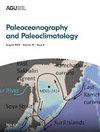Development and Application of the Branched and Isoprenoid GDGT Machine Learning Classification Algorithm (BIGMaC) for Paleoenvironmental Reconstruction
IF 3.2
2区 地球科学
Q2 GEOSCIENCES, MULTIDISCIPLINARY
引用次数: 2
Abstract
Glycerol dialkyl glycerol tetraethers (GDGTs), both archaeal isoprenoid GDGTs (isoGDGTs) and bacterial branched GDGTs (brGDGTs), have been used in paleoclimate studies to reconstruct environmental conditions. Since GDGTs are produced in many types of environments, their relative abundances also depend on the depositional setting. This suggests that the distribution of GDGTs also preserves useful information that can be used more broadly to infer these depositional environments in the geological past. Here, we combined existing iso‐ and brGDGT relative abundance data with newly analyzed samples to generate a database of 1,153 samples from several modern sedimentary settings. We observed a robust relationship between the depositional environment and the relative abundances of GDGTs in our samples. This data set was used to train and test the Branched and isoGDGT Machine learning Classification (BIGMaC) algorithm, which identifies the environment a sample comes from based on the distribution of GDGTs with high precision and recall (F1 = 0.95). We tested the model on the sedimentary record from the Giraffe kimberlite pipe, an Eocene maar in subantarctic Canada, and found that the BIGMaC reconstruction agrees with independent stratigraphic and palynological information, provides new information about the paleoenvironment of this site, and helps improve its paleotemperature reconstruction. In contrast, we also include an example from the PETM‐aged Cobham lignite as a cautionary example that illustrates the limitations of the algorithm. We propose that in cases where paleoenvironments are unknown or are changing, BIGMaC can be applied in concert with other proxies to generate more refined paleoclimate records.用于古环境重建的分支类异戊二烯GDGT机器学习分类算法(BIGMaC)的开发与应用
甘油二烷基甘油四醚(GDGTs),既有古生类异戊二烯GDGTs(isoGDGTs,isoGDGTs),也有细菌分支GDGTs。由于GDGTs在许多类型的环境中产生,其相对丰度也取决于沉积环境。这表明GDGT的分布也保留了有用的信息,可以更广泛地用于推断地质历史中的这些沉积环境。在这里,我们将现有的iso和brGDGT相对丰度数据与新分析的样本相结合,生成了一个由几个现代沉积环境中的1153个样本组成的数据库。我们观察到沉积环境与样品中GDGTs的相对丰度之间存在着密切的关系。该数据集用于训练和测试Branched和isoGDGT机器学习分类(BIGMaC)算法,该算法基于GDGT的分布以高精度和召回率(F1=0.95)来识别样本所处的环境,并发现BIGMaC重建符合独立的地层和孢粉学信息,为该遗址的古环境提供了新的信息,有助于改进其古温度重建。相比之下,我们还包括了一个PETM老化Cobham褐煤的例子,作为说明算法局限性的警示性例子。我们建议,在古环境未知或正在变化的情况下,BIGMaC可以与其他代理一起应用,以生成更精细的古气候记录。
本文章由计算机程序翻译,如有差异,请以英文原文为准。
求助全文
约1分钟内获得全文
求助全文
来源期刊

Paleoceanography and Paleoclimatology
Earth and Planetary Sciences-Atmospheric Science
CiteScore
6.20
自引率
11.40%
发文量
107
期刊介绍:
Paleoceanography and Paleoclimatology (PALO) publishes papers dealing with records of past environments, biota and climate. Understanding of the Earth system as it was in the past requires the employment of a wide range of approaches including marine and lacustrine sedimentology and speleothems; ice sheet formation and flow; stable isotope, trace element, and organic geochemistry; paleontology and molecular paleontology; evolutionary processes; mineralization in organisms; understanding tree-ring formation; seismic stratigraphy; physical, chemical, and biological oceanography; geochemical, climate and earth system modeling, and many others. The scope of this journal is regional to global, rather than local, and includes studies of any geologic age (Precambrian to Quaternary, including modern analogs). Within this framework, papers on the following topics are to be included: chronology, stratigraphy (where relevant to correlation of paleoceanographic events), paleoreconstructions, paleoceanographic modeling, paleocirculation (deep, intermediate, and shallow), paleoclimatology (e.g., paleowinds and cryosphere history), global sediment and geochemical cycles, anoxia, sea level changes and effects, relations between biotic evolution and paleoceanography, biotic crises, paleobiology (e.g., ecology of “microfossils” used in paleoceanography), techniques and approaches in paleoceanographic inferences, and modern paleoceanographic analogs, and quantitative and integrative analysis of coupled ocean-atmosphere-biosphere processes. Paleoceanographic and Paleoclimate studies enable us to use the past in order to gain information on possible future climatic and biotic developments: the past is the key to the future, just as much and maybe more than the present is the key to the past.
 求助内容:
求助内容: 应助结果提醒方式:
应助结果提醒方式:


